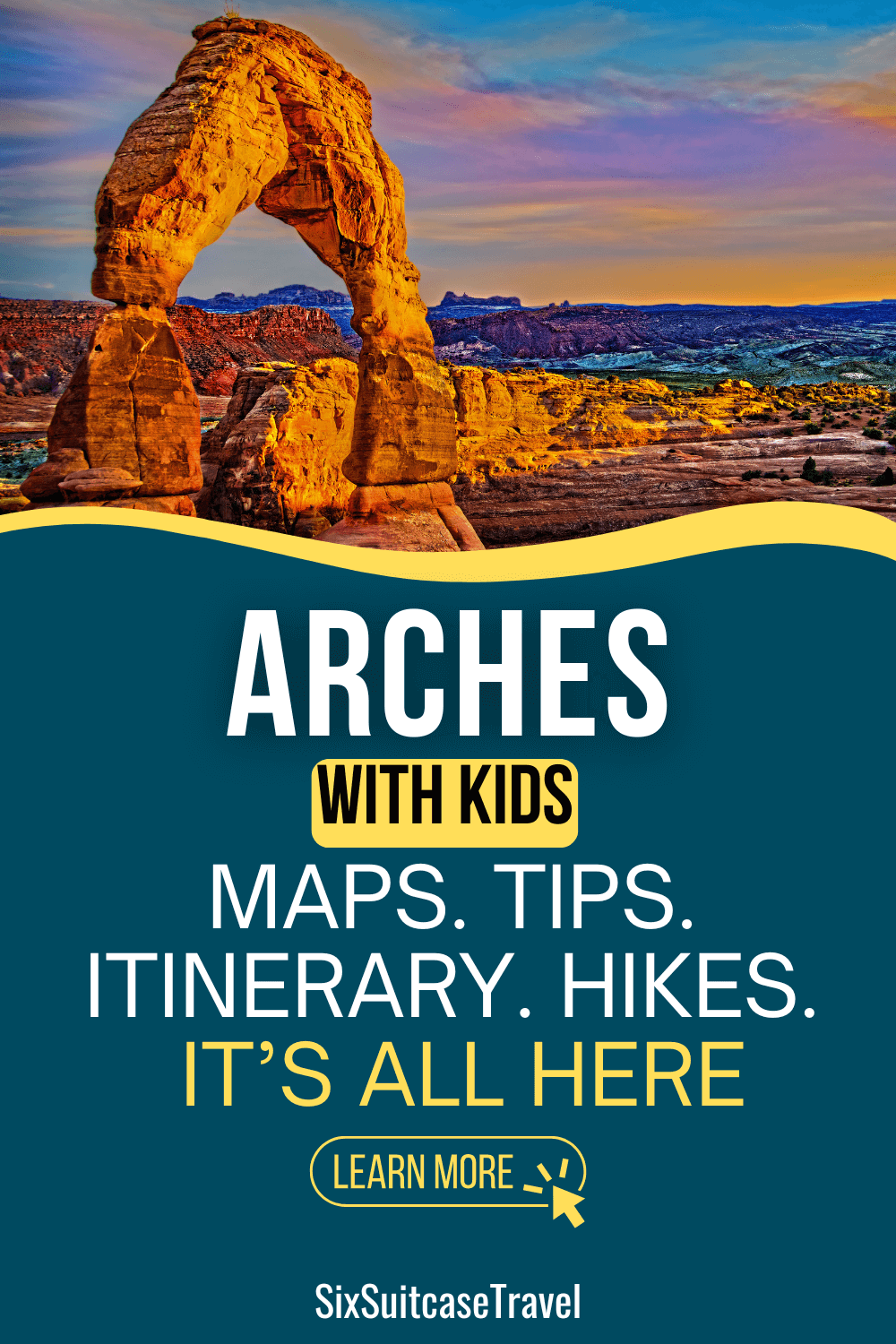
The Delicate Arch famously appears on Utah license plates, but did you know there are more than 2,000 nature sandstone arches in the park? You’ll also see massive fins, giant balanced rocks, monoliths, and pinnacles as your big family explores this grand park. Whether you enjoy the park from the viewpoints or get out to hike the many trails, your big family will enjoy a trip to Arches National Park.
Drawing from our firsthand visit and extensive research, this guide aims to help your family navigate and enjoy the wonders of Arches National Park.
- How to get to Arches National Park
- Timed Entry System at Arches
- Best Things to Do in Arches National Park
- 10 Best Overlooks and Viewpoints
- Hiking at Arches National Park
- How Many Days Do You Need at Arches National Park?
- Entrance Fees for Arches National Park
- Can You see Arches and Canyonlands in One Day?
- Best Time to Visit Arches National Park
- Protect the Fragile Desert Soil
- Experience the Incredible Night Skies
- 12 Tips for Visiting
- Where to Stay
- Ideas to Plan Your trip
- Park Map
How to get to Arches National Park
Located in southeast Utah, Arches National Park is 5 miles north of Moab off of Highway 191. The park has only one Entrance station.
- 110 miles southwest of Grand Junction, Colorado, or about a 1-hour and 40-minute drive
- 236 miles southeast of Salt Lake City, Utah, which is around a 3-hour and 43-minute drive
- 360 miles southwest of Denver, Colorado, or about a 5-hour and 36-minute drive
Timed Entry System at Arches
Arches National Park operates a timed-entry reservation system from April 1 through July 6 and August 28 – October 31, aimed at managing the high volume of visitors and preserving the park’s natural beauty. Timed Entry Tickets are released in monthly blocks—three months in advance—and are available for purchase through Recreation.gov.
If you weren’t able to snag a ticket in advance, don’t worry! A limited number of tickets may also be available the day before your visit on Recreation.gov, which is perfect for last-minute planners. Be sure to check early, as these can sell out quickly. Remember that tickets grant access during a one-hour arrival window, so plan to arrive within your designated time frame.
Best Things to Do in Arches National Park
- Drive the 22-mile-long scenic drive, stop at all the pull-outs, viewpoints, and overlooks
- Hike one of the many trails in the park
- Visit the Visitor Center – watch the orientation film, view the exhibits, and browse the sale items
- Want a full-immersion experience? Book a 4×4 Off-Roading Adventure Tour.
10 Best Overlooks and Viewpoints
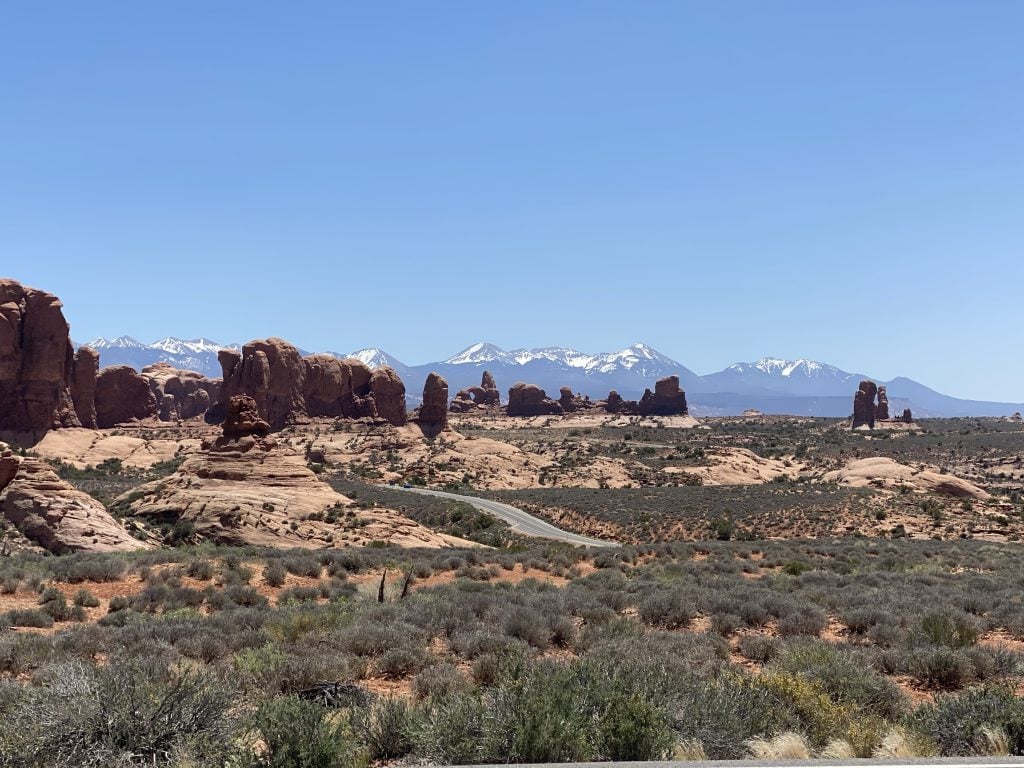
1. Garden of Eden Parking Lot
- Distance from Entrance: About 4 miles (10-15 minutes’ drive).
- Description: This location offers stunning 360-degree views of various rock formations, including massive fins, pinnacles, and boulders scattered like a natural sculpture garden. The Garden of Eden is a great place to soak in the essence of Arches without much hiking and enjoy unique photo opportunities.
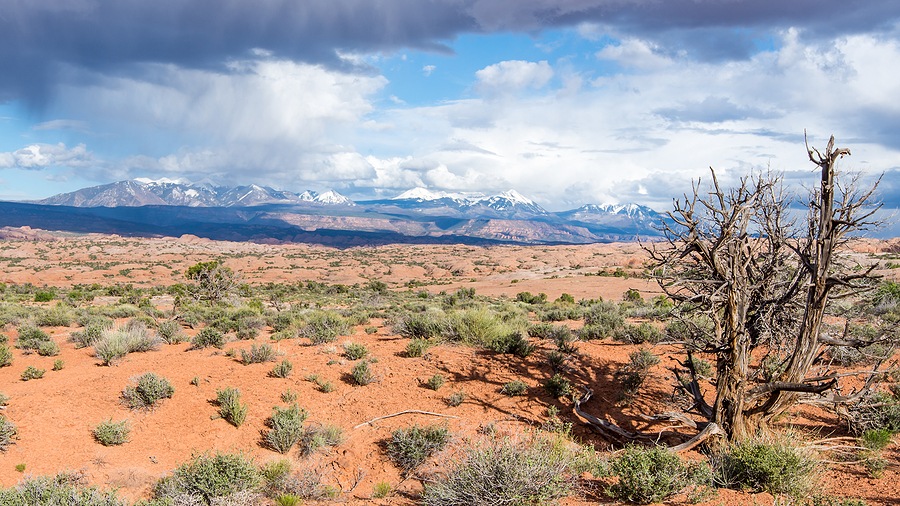
2. La Sal Mountains Viewpoint
- Distance from Entrance: Approximately 3 miles (5 minutes’ drive).
- Description: This viewpoint provides a striking landscape featuring the vast desert foreground juxtaposed against the distant La Sal Mountains. It’s a perfect stop to admire the contrast between red rock formations and the snow-capped peaks in the distance, especially during sunrise or sunset.
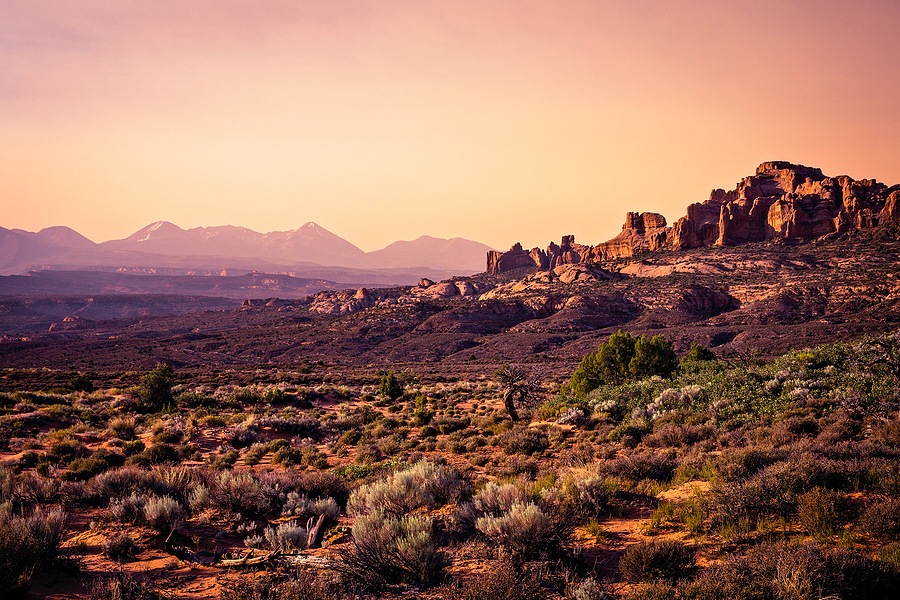
3. Panorama Point
- Distance from Entrance: About 13 miles (20 minutes’ drive).
- Description: As its name suggests, this viewpoint offers sweeping views across the park, including the La Sal Mountains, Fiery Furnace, and Devils Garden area. It’s also an excellent spot for stargazing, as the area is known for its incredible night skies. Check with the National Park Service for potential star party events here.
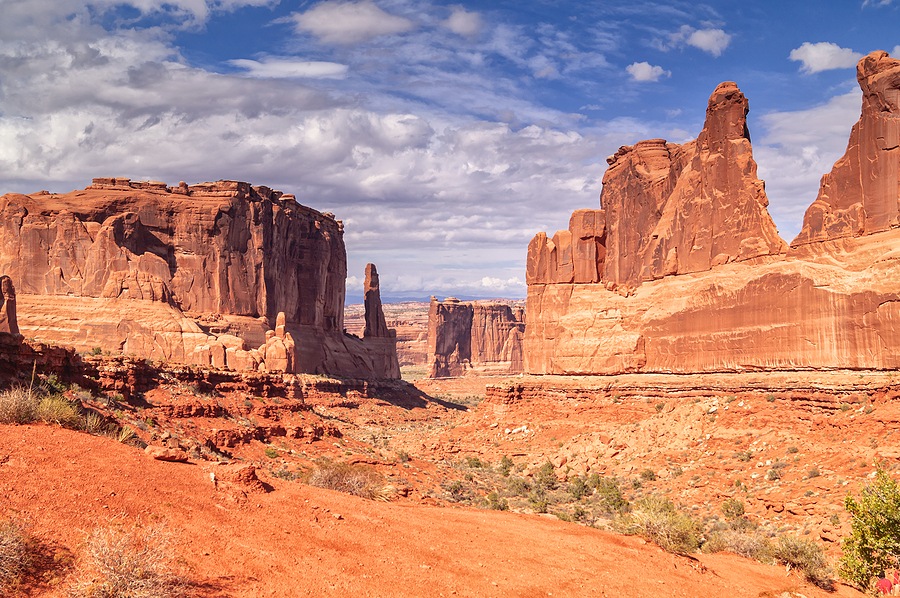
4. Park Avenue Viewpoint
- Distance from Entrance: Less than 1 mile (2-3 minutes’ drive).
- Description: This dramatic viewpoint features a canyon-like corridor of towering sandstone walls, likened to the skyscrapers of New York City’s Park Avenue. It’s a stunning welcome to the park and the first major viewpoint after entering. For a closer look, you can take a short hike down into the canyon (1 mile one way).
5. Fiery Furnace Viewpoint
- Distance from Entrance: Approximately 14 miles (25 minutes’ drive).
- Description: From here, you can marvel at the intricate maze of narrow sandstone canyons and fins that make up Fiery Furnace. The area appears to glow orange and red under sunlight, hence its name. For those looking for an adventurous experience, ranger-guided hikes are available, though they require reservations.
6. Salt Valley Overlook
- Distance from Entrance: Around 11.5 miles (20 minutes’ drive).
- Description: This overlook gives visitors a sweeping view of the arid Salt Valley basin, with its sprawling desert floor surrounded by jagged rock formations. It’s an excellent stop for landscape photography and for understanding the unique geology of the park.
7. The Windows Section (North and South Windows, Turret Arch)
- Distance from Entrance: About 12 miles (20 minutes’ drive).
- Description: This incredibly popular area allows visitors to view the North and South Window Arches and Turret Arch clustered together. It’s a short walk from the parking area, and the formations are particularly stunning in the golden light of sunrise or sunset.
8. Delicate Arch Viewpoints (Lower and Upper)
- Distance from Entrance: 13 miles (30 minutes’ drive).
- Description: From these viewpoints, you can admire Delicate Arch from varying distances without undergoing the strenuous 3-mile hike. The Lower Viewpoint is a quick 300-foot walk, while the Upper Viewpoint requires a 0.5-mile uphill hike for a closer perspective. Keep in mind that even the Upper Viewpoint doesn’t let you get near the arch itself.
9. Petrified Dunes Viewpoint
- Distance from Entrance: About 7 miles (15 minutes’ drive).
- Description: This underrated viewpoint showcases large, wavy petrified dunes, which were once massive sand dunes solidified into rock over time. The view is vast and gives a unique look at the park’s geologic history, contrasted against the surrounding red rock formations.
10. Devils Garden Trailhead
- Distance from Entrance: About 18 miles (35 minutes’ drive).
- Description: Though primarily known as a starting point for several of the park’s longer hikes, like the trail to Landscape Arch or Double O Arch, the parking area itself offers beautiful views of surrounding rock features and provides a great place to begin your exploration of the park’s northern end.
Hiking at Arches National Park
With three categories of hikes at Arches, you’ll easily find several hikes that will suit your big family’s ability and skill level. For families with smaller kids, we recommend any of the hikes listed as Easy, although most are not stroller-friendly. These easy hikes offer a mix of family-friendly options to explore the incredible rock formations and landscapes of Arches National Park without requiring much effort.
Easy Hikes at Arches to do with Kids
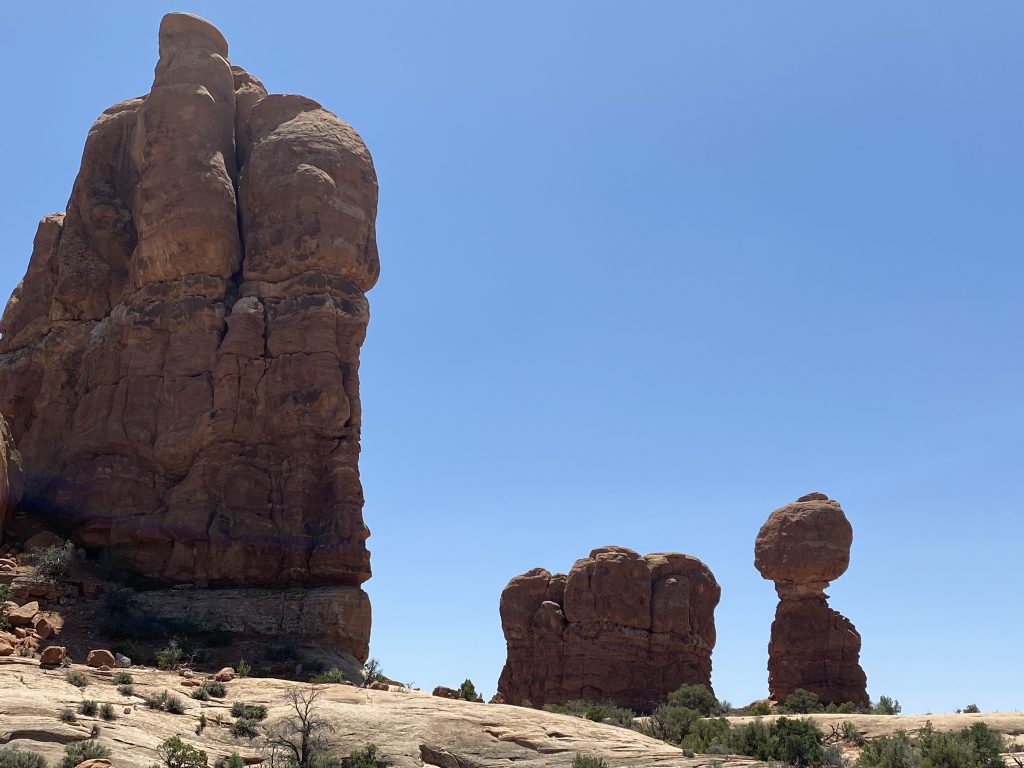
- Balanced Rock (0.3-mile round trip) This short, stroller-friendly trail takes you up close to one of the most iconic rock formations in the park. The massive, precariously balanced sandstone rock atop a narrow pedestal is a fascinating display of erosion.
FUN FACT: Scenes from Indiana Jones and the Last Crusade were shot here.
- Double Arch (0.5-mile round trip). Located in the Windows Section of the park, this trail leads to two huge arches that share the same base, forming an impressive and unique formation. The amphitheater-like area beneath the arches is a great spot for photos and for kids to marvel at the towering natural structure.
- The Windows (1.0-mile round trip). This family-friendly trail lets you view three beautiful arches—North Window, South Window, and Turret Arch – all in one easy hike. The path is relatively flat, with incredible photo opportunities at every turn. Sunrise is especially spectacular here as the golden light illuminates the arches.
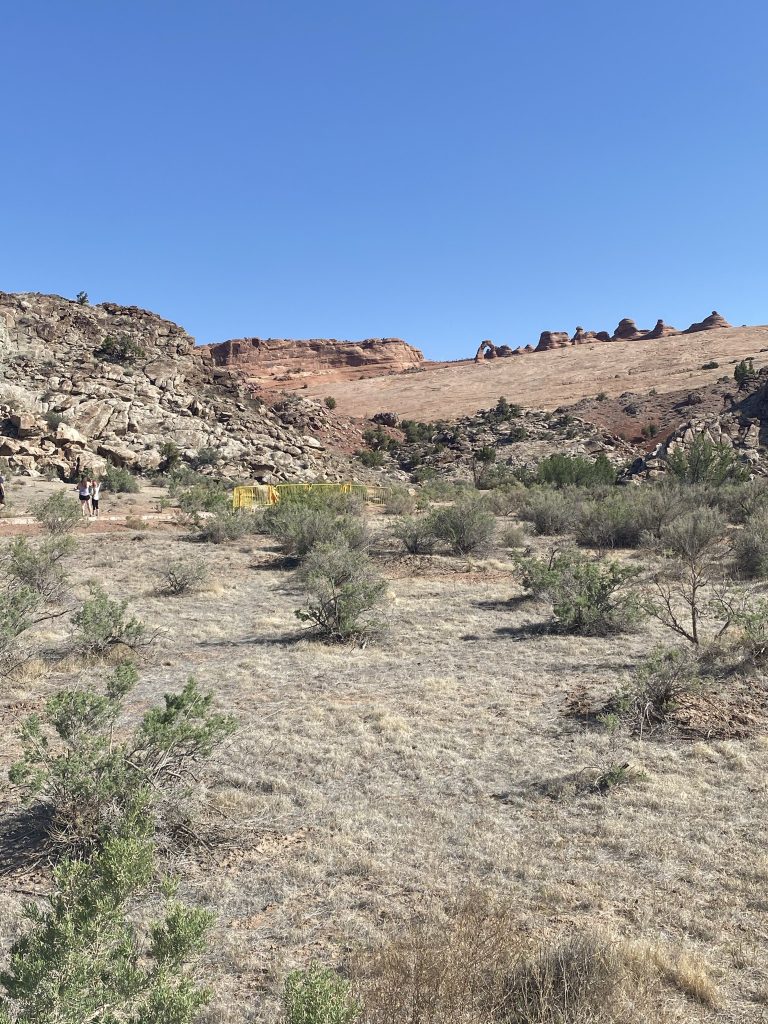
- Delicate Arch Lower Viewpoint (300 feet) This extremely short walk takes you to a viewpoint where you can see Utah’s famous Delicate Arch from a distance. While the arch is small on the horizon, this is a great option for those who want to catch a glimpse without making the strenuous hike to the arch itself..
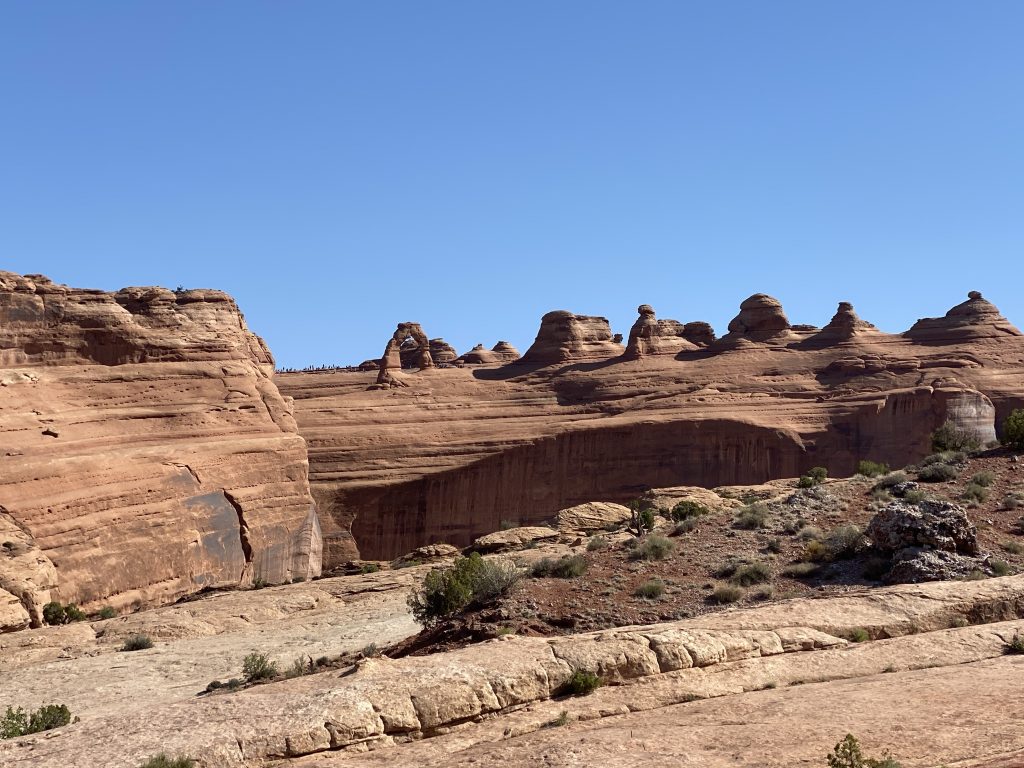
- Delicate Arch Upper Viewpoint (0.5 miles). Though slightly more challenging than the lower viewpoint, this trail leads hikers to a closer perspective of Delicate Arch. The uphill walk provides better views of the famous formation and the rugged surrounding landscape. Great for those who want a middle ground between easy access and stunning views.
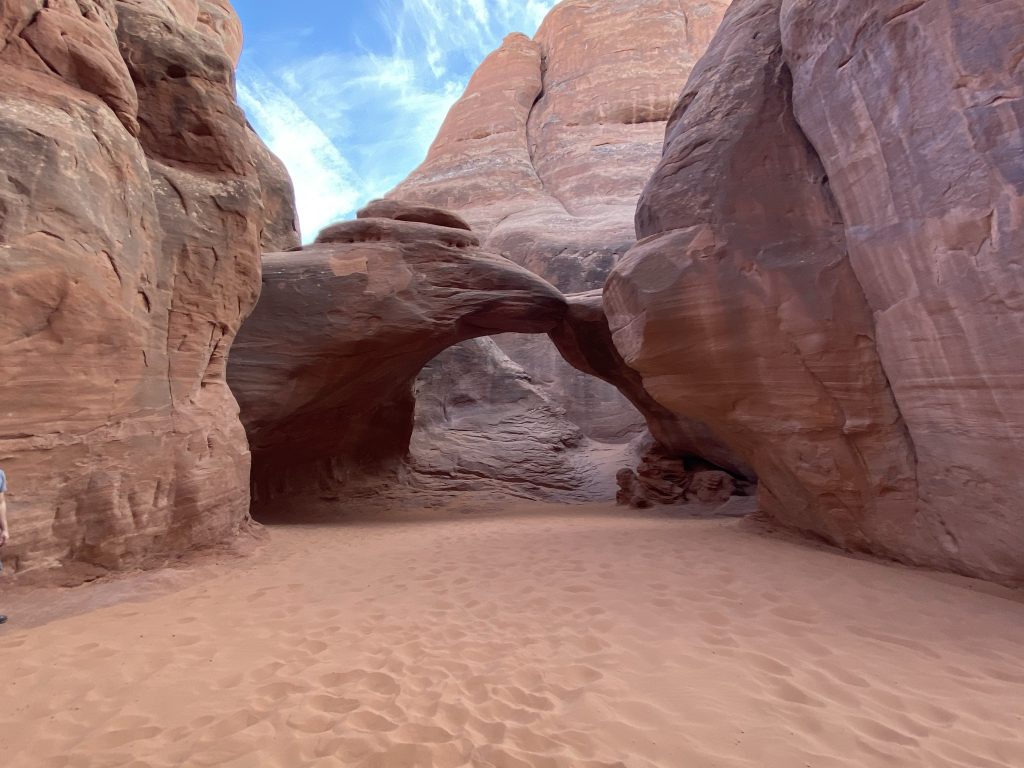
- Sand Dune Arch (0.3 miles round trip). The short walk to this hidden gem takes you through a shaded, sandy area tucked between rock fins, making it a favorite for young kids who can play in the cool, soft sand. The arch itself is surrounded by towering walls, creating a secluded and magical atmosphere.
- Broken Arch (1.3 miles or 1.5-mile loop with Sand Dune Arch). This easy hike passes through an open desert landscape, leading to an elegantly cracked arch that gives it its name. Pair it with Sand Dune Arch for a fun and varied loop where you’ll walk through both sandy areas and open spaces surrounded by stunning rock formations.
- Tapestry Arch (2.7-mile loop with Sand Dune and Broken Arches). This trail offers a longer, leisurely loop that integrates stops at Sand Dune Arch and Broken Arch before leading you to the intricate, intricate Tapestry Arch. The arch gets its name from its textured surface, which looks like woven fabric. This hike offers a wonderful variety of landscapes and formations.
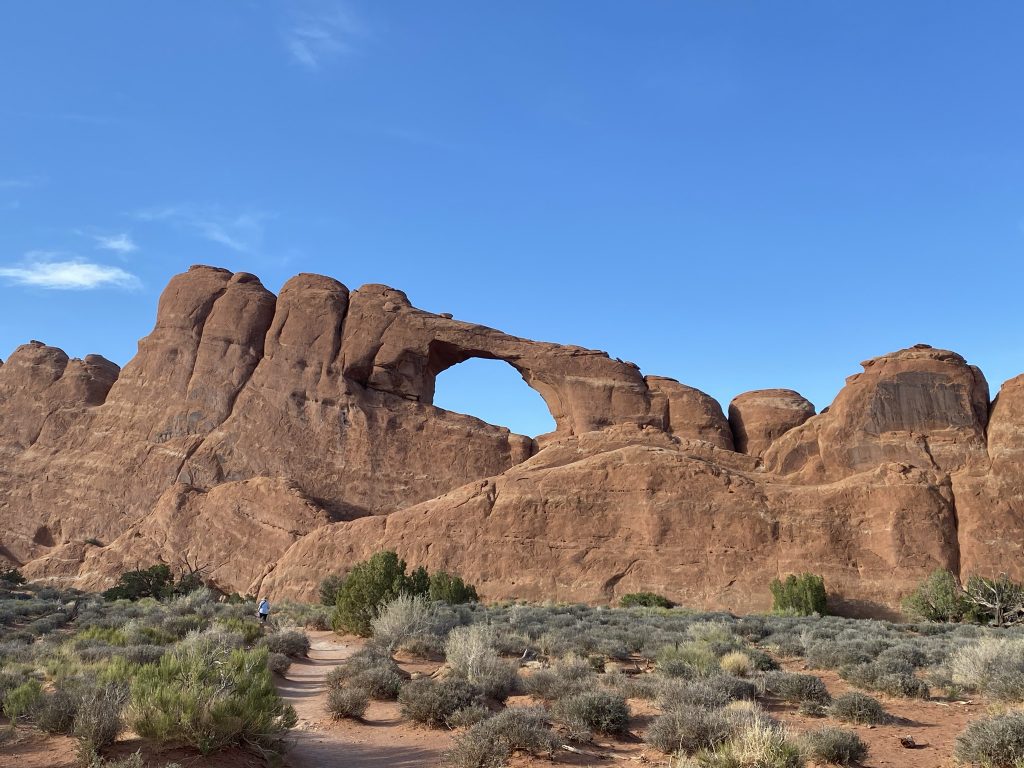
- Skyline Arch (0.4-mile round trip). Visible even from the road, this short trail takes you closer to one of the park’s most photogenic arches. The arch dramatically pierced through rock after a massive boulder fell from it in 1940, nearly doubling the size of the opening. Look carefully at the rock pile below to see where the boulder once rested.
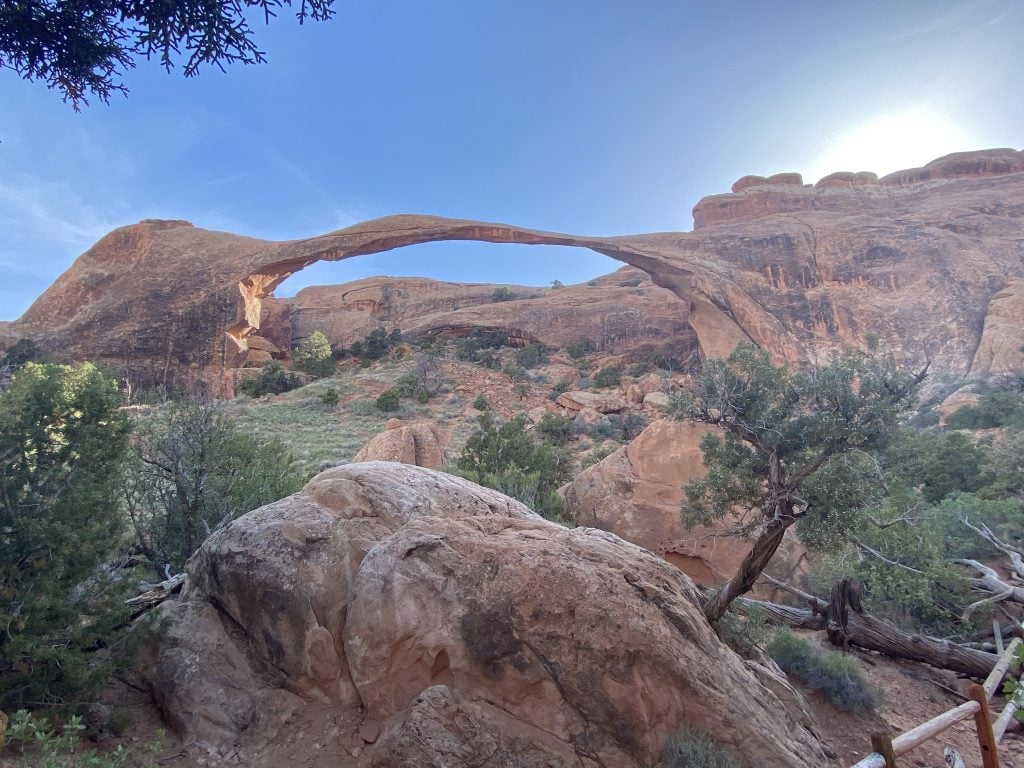
- Landscape Arch (1.6 miles round trip). This hike takes you to the longest natural arch in North America, an almost impossibly thin ribbon of stone stretching 306 feet. The trail is flat and easy, allowing you to enjoy the dramatic view of the arch as it gracefully defies gravity. Be sure to stay on the trail, as falling rock has closed the area beneath the arch to visitors.
Moderate Hikes at Arches
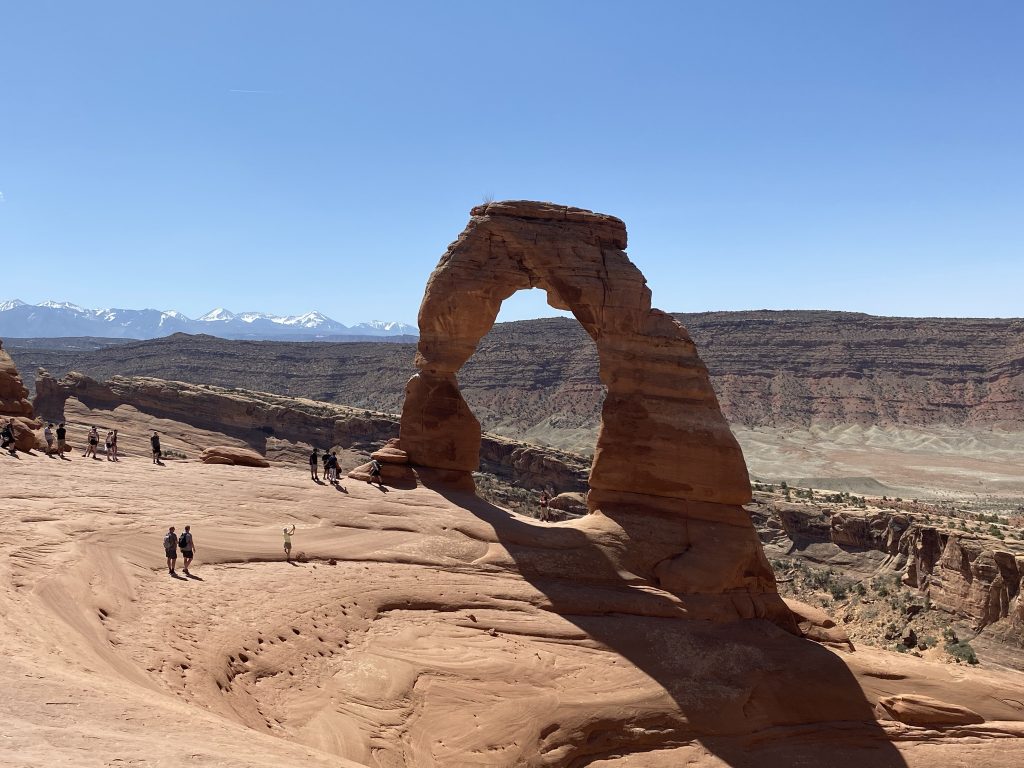
- Delicate Arch, 3.0 miles. Some might consider this hike rated as strenuous, as most of the hike is straight uphill Slickrock with little to no shade. To be honest, I whined and complained the last third up to the Arch. The last 40 feet of the hike is a narrow ledge that hugs a rock wall with steep drop-offs. Look for the Twisted Doughnut Arch on your right before going around the last bend. The opening of the arch is 45 feet high and 33 feet wide. Plan on spending 3 hours to cover this hike.
- Park Avenue, 1.0 mile one way. Stroll through soaring sandstone formations that have been compared to the skyscrapers of New York City. You don’t have to hike the whole way to enjoy the spectacular view.
Strenuous Hikes at Arches
These strenuous hikes challenge visitors but reward them with incredible scenery and some of Arches National Park’s most iconic geologic features. They are best suited for experienced hikers prepared for uneven terrain and sometimes difficult navigation.
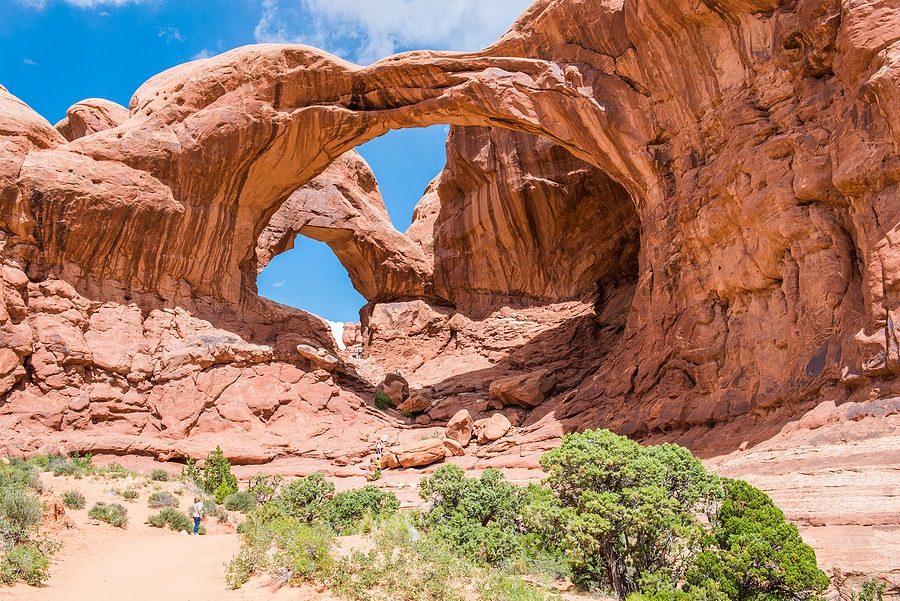
- Double O Arch (4.2 miles round trip). This challenging hike in the Devils Garden area takes you to one of the park’s most unique formations—two arches stacked on top of each other, creating a beautiful and rare sight. The trail includes sections of uneven terrain, steep climbs, and narrow ledges, making it thrilling for seasoned hikers.
- Fiery Furnace (varies; ranger-guided, reservation needed). Fiery Furnace is not a specific trail but a labyrinth of narrow sandstone canyons and fins that require permits or a guided tour to hike. This strenuous adventure involves scrambling over rocks and squeezing through tight spaces, with no marked trails to follow, making it a true exploration. Starting in 2025, the hiking zone is closed due to staffing shortages.
- Devil’s Garden Trails (7.2 miles round trip). This trail offers an incredible adventure through some of the park’s most famous arches, including Landscape Arch, Navajo Arch, and Double O Arch. The challenging terrain includes climbing steep rock faces and navigating narrow paths, rewarding hikers with breathtaking views and iconic formations.
- Tower Arch (3.4 miles round trip). Located in a more remote section of the park, this trail leads to the massive Tower Arch, tucked within a stunning desert landscape. The hike involves a steep initial ascent followed by undulating terrain through sandy washes and over slickrock, providing a more secluded experience away from crowds.
- Primitive trail from Double O Arch to Landscape Arch (2.2 miles). This extension loop from the Devils Garden Trail offers an adventurous route filled with narrow ledges, rocky scrambles, and steep inclines. The trail is less maintained, making it ideal for those seeking solitude and a closer connection to the rugged beauty of the park.
How Many Days Do You Need at Arches National Park?
Depending on how much your big family likes to hike, you could cover the park in one day. I suggest covering it in two days, the day of arrival in the late afternoon/early evening (about a 3-4 hour visit) and most of the next day (about a 6-hour visit).
One-Day Itinerary
To see most of the park in one day, keep your schedule limited to the short, easy hikes and view as many overlooks and viewpoints as you can squeeze in. I suggest arriving early and driving to the furthest point, Devils Garden Trailhead first.
- Drive to the Devils Garden Trailhead and hike to Landscape Arch
- Hike Sand Dune Arch and Broken Arch
- Stop at Fiery Furnace Viewpoint and Salt Valley Overlook
- View Delicate Arch from Upper and Lower Viewpoints
- Drive to The Windows Section to view the North and South Window, and Double Arch
- Stop at the Garden of Eden parking lot for 360-degree views
- Drive to the Petrified Dunes Viewpoint
- Visit the La Sal Mountains Viewpoint
- Stop at the Visitor Center to become a Junior Ranger. Open daily from 9 am to 4 pm.
Two-Day Itinerary
If you schedule two days, you can include one of the moderate or strenuous hikes, such as Delicate Arch. For a two-day itinerary, include everything from day one, and on the second day, add the following activities.
- Arrive early and drive straight to the Wolf Ranch parking lot to hike Delicate Arch. This hike will take around 3 hours.
- Visit the Visitor Center during peak afternoon to cool off and relax during the orientation film
- Hike Park Avenue
Entrance Fees for Arches National Park
We highly recommend buying an America the Beautiful pass for $80. The pass is good for one calendar year and is your ticket to more than 2,000 federal recreation sites. Having a pass will allow you to pop in for a few hours in the evening and again the next morning.
If you have a 4th grader, check out the FREE Annual 4th Grade pass, which is good for the duration of the school year through the following summer (September-August).
Current U.S. military members and their dependents in the Army, Navy, Air Force, Marines, Coast Guard, and Space Force, as well as Reserve and National Guard members, qualify for a free annual pass.
Can You see Arches and Canyonlands in One Day?
It is possible to see Arches and Canyonlands in one day, although I don’t recommend it. However, if your family is not into hiking or has mobility limitations, there are plenty of gorgeous outlooks, viewpoints, parking lots, and pull-outs to view the beauty of both parks in one day. You can cover Arches in about three hours by driving the Scenic Drive and scheduling a 10-minute stop at each viewpoint.
Best Time to Visit Arches National Park
Mid-May is a great time to visit. Although I know it’s hard to travel with kids in mid-May, if your crew is college-aged or more, May is a great time to visit. The temperature is about perfect.
You can plan a trip any month of the year. However, June, July, and August are the hottest months with temperatures near 100 degrees. Visits during the winter months will find cooler temperatures and a chance of snow in December.
Protect the Fragile Desert Soil
When visiting Arches National Park, it’s important to stay on marked trails and paths to help protect the park’s unique and delicate ecosystem. The desert soil, often referred to as cryptobiotic soil, is alive and made up of living organisms like cyanobacteria, fungi, and mosses. This “living soil” binds loose particles together, preventing erosion and enabling plant life to thrive in the harsh desert environment.
Stepping off trails can crush this fragile soil, causing damage that can take 50 to 200 years to recover. To ensure future generations can enjoy the beauty of the park, encourage kids to stay on the paths and explain the importance of protecting the environment.
Make it a fun game for kids by challenging them to “follow the leader” and see who can spot the trail markers first. This not only helps prevent damage but also keeps younger visitors engaged during hikes.
Experience the Incredible Night Skies
Arches National Park is designated as an International Dark Sky Park, making it one of the best places in the world for stargazing. The park’s desert location and lack of light pollution create perfect conditions for an unforgettable view of the Milky Way, constellations, and even meteor showers.
For the best stargazing experience:
- Visit Panorama Point: This area is known for its expansive views and is considered one of the park’s top stargazing spots.
- Try stargazing near iconic formations like The Windows Section or Balanced Rock for stunning foregrounds in your night photography.
- Bring a star map or download a stargazing app to help identify constellations, planets, and other celestial objects.
- Check the moon phase calendar before your trip as a new moon provides the darkest skies for the clearest view of stars.
- Pack a blanket, warm layers, and a flashlight or headlamp (with a red light setting to preserve night vision).
If visiting during peak times for celestial events (e.g., meteor showers), arrive early to find a good spot. The National Park Service sometimes offers special Ranger-Led Night Sky Programs, so check the Visitor Center or their website for information.
12 Tips for Visiting
- If you arrive in Moab midday, split your Arches National Park visit into two days. Complete some of the easy hikes in the late afternoon and evening of the first day and save one of the longer hikes such as Delicate Arch for the next morning. We were able to hike Skyline Arch and Landscape Arch the first evening we were in Moab.
- Visit early. Delicate Arch/Wolfe Ranch parking lot fills up fast. During our visit, some people parked at the Lower Delicate viewpoint parking lot and walked the mile to the Delicate Arch trailhead.
- Know Where the Restrooms Are Located. Restrooms are available at key locations throughout the park, and knowing where they are can make your trip much smoother, especially for families with kids. Most major parking areas have restroom facilities, including:
- Visitor Center: Flush toilets are available.
- Devils Garden Trailhead: Vault toilets.
- Wolfe Ranch (Delicate Arch Trailhead): Vault toilets.
- The Windows Section parking area: Vault toilets.
- Sand Dune Arch parking area: Vault toilets.
- Balanced Rock parking area: Vault toilets.
- Make note that many of these restrooms are vault toilets, and they may not be stocked with all supplies during peak seasons, so it’s a good idea to carry some extra tissue and hand sanitizer with you. Planning your stops around these facilities can help ensure a more comfortable visit for everyone in your group.
- Pack Body Wipes to Freshen Up After Hikes. Hiking in the desert heat can leave everyone feeling sweaty and uncomfortable, especially kids. Packing body wipes is a simple and effective way to freshen up after a hike. These wipes can help remove sweat, dirt, and sand, leaving everyone feeling clean and refreshed
- If you have stroller-aged or young walkers, we recommend using a baby/toddler carrier as most hikes are not stroller-friendly.
- Learn about the park by becoming a Junior Ranger at the Visitor Center.
- Have comfortable hiking gear. Many trails are sandy, high-top hiking boots are recommended. Hats and sunscreen to protect from the sun are also needed.
- Stay on the trails to help protect desert life. Desert soils or cryptobiotic soil have living organisms that bind loose, fragile soils together to support plant and animal life. Disrupting the soil can cause a setback of 50-200 years.
- Avoid hiking the longer trails, such as Delicate Arch in the heat of the day in July and August when temperatures can reach 100 degrees.
- Don’t miss the Ute Petroglyphs near Wolf Ranch.
- Check for sunrise times and head to the park 30-45 minutes before. Since the park is open 24 hours, your crew can enjoy the light crowds and beautiful sunrise at your favorite arch. Don’t forget to add the drive time from the Entrance Station. The entrance to the Delicate Arch Trailhead is 30-35 minutes of drive time.
- Pack plenty of water and snacks and take many breaks to drink and eat.
Where to Stay
Hotels near Arches National Park
Check out our list of hotels in Moab for big families. During this visit, we stayed at the Comfort Suites.
Camping and RVing near Arches National Park
Inside the park, you can make camping reservations at the Devils Garden Campground. The site contains 51 campsites. Sites range in length from 20 to 40 feet and allow Trailers and RVs less than 40 feet.
Moab Vacation Rentals
If you don’t mind staying a little further out or if you plan on staying three or more days in the Moab area, a vacation rental can make a great base for your vacation.
Ideas to Plan Your trip
Arches National Park was an unforgettable part of our 8-day Grand Circle Road Trip, including the Grand Canyon and exploring Utah’s Mighty 5 National Parks. The dramatic arches, breathtaking landscapes, and family-friendly hikes made it a highlight of our journey.
For those considering an extended adventure, we also have a 5-day itinerary for visiting Salt Lake City with kids and a detailed guide to eight incredible Utah State Parks featuring big family cabins. These resources are designed to make planning your family vacation easy, memorable, and full of adventure. Don’t miss the chance to create lifelong memories with your loved ones in Utah’s stunning outdoors.
Park Map
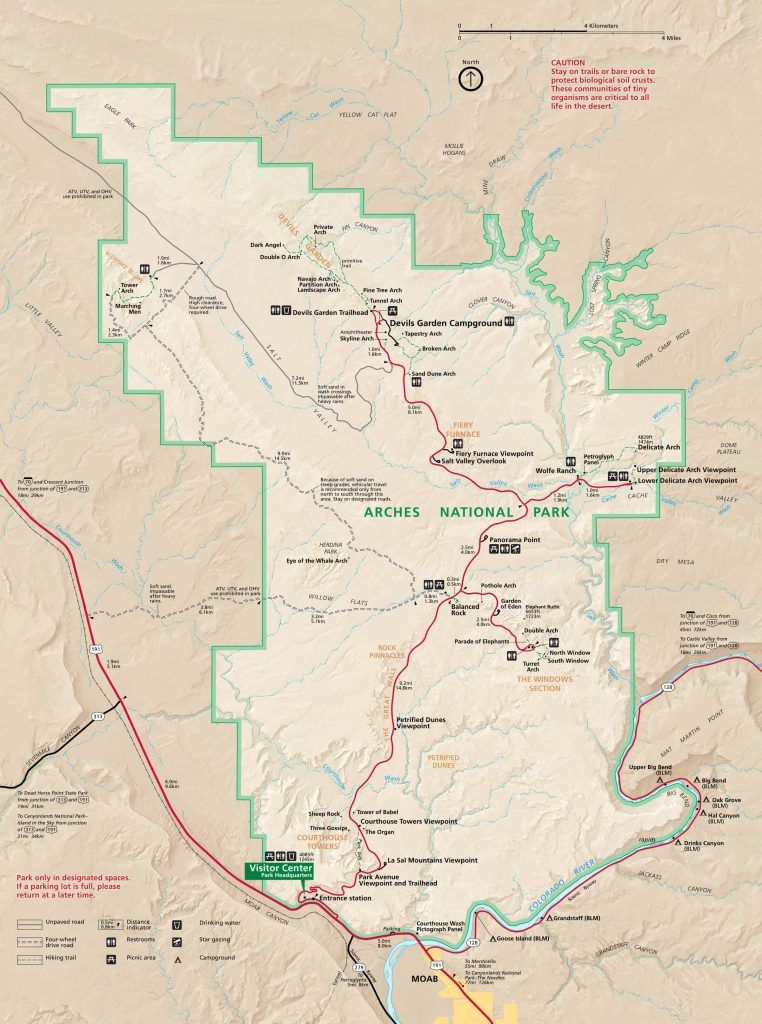
Pin for Later!
